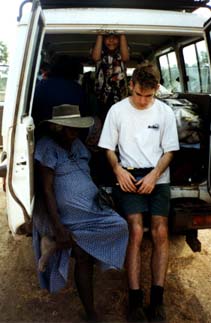
About the dictionary
 |
The Wagiman online dictionary About the dictionary |
| Welcome | Dictionary | About the dictionary | Language & speakers | Wagiman texts | Links & references |
[How to use the dictionary | About the dictionary | How the dictionary was made | Acknowledgements]
To get to the dictionary, simply click the green tab labelled "Dictionary", which appears on every page.
Below the banner on the left, you will see some of the letters from b through to w. These are the letters which Wagiman words can start with. You can click on a letter to be taken to that page of the dictionary.
There is also a link labelled "IPA", which stands for International Phonetic Alphabet. Clicking this link will load alternative versions of the dictionary pages which include IPA transcriptions of each word. To view these, you will need the font SILDoulosIPA, which can be downloaded for free from the Summer Institute of Linguistics.
Then there is a text box where you can enter English or Wagiman words which you would like to search for. Simply type in a word, or the first letters of it, choose the language of the word you have typed in, and press "Search". If the word can be found, you will be taken to its entry.
Below this frame is an English word finder list. Each English word is translated by one or more Wagiman words. You can click on a Wagiman translation to be taken to the entry for that word in the dictionary.
On the right hand side of the screen is the dictionary itself. There is one page for each letter of the alphabet which Wagiman words can start with.
The entry for each word always shows at least the following three things:
The Wagiman dictionary contains about 1 500 words at present. The dictionary is, and always will be, a work in progress. The words collected here represent only a small fraction of what would have been the vocabulary of the language when it was the vernacular of daily life for its speakers. Even now, there are probably still hundreds more words which are known by today's speakers but which have not been recorded. We hope to add to the dictionary in time as more work is done with the Wagiman people. In addition, presently only words are included, not inflectional or derivational morphemes, or place names.

This dictionary is based on work carried out with five Wagiman speakers: Lulu Martin Dalpbalngali, Helen Liddy Emorrotjba, Paddy Huddlestone Benbo, Clara McMahon Gumbirtbirtda and Lenny Liddy Gapbuya.
A first draft Wagiman dictionary was put together by Mark Harvey in 1994, working mostly with Lulu Martin, although Mark also consulted with several other Wagiman speakers. More fieldwork on the language has been carried out by Stephen Wilson between 1996 and 1999, and Mark Harvey in 1998 and 1999.
This online dictionary was put together by Stephen Wilson in 1999. First the existing draft dictionary had to be thoroughly revised. This involved things such as checking phonetic forms, examining meanings, collecting example sentences, and so on. Work on the dictionary was carried out using Microsoft Access, a relational database which enables many different types of information to be stored about each word. The dictionary web pages and the English word finder were created automatically from the database with a Visual Basic program. When the dictionary is updated in the future, this program can simply be run again to update the web pages. A similar program was used to produce a hard copy of the dictionary. Linguists (and others) who are interested in obtaining more information about how the dictionary was made are welcome to contact Stephen Wilson. Source files can be provided to anyone who might be interested in putting together a similar dictionary for another language.
Most of the plant and animal identification was carried out by Glenn Wightman and Mark Harvey, in consultation with all of the Wagiman speakers named above. Most of the descriptions of traditional usages which accompany some of the plant and animal entries were written by Glenn Wightman, based on his discussions with Wagiman people.
The people who have contributed most to this dictionary are the Wagiman speakers named above: Lulu Martin Dalpbalngali, Helen Liddy Emorrotjba, Paddy Huddlestone Benbo, Clara McMahon Gumbirtbirtda and Lenny Liddy Gapbuya. It has been their knowledge and patience which has made this project possible, so many thanks to them.
Thanks to Jane Simpson and Denise Angelo, who have helped Stephen in his study of Wagiman, Chris Manning, for useful discussions on electronic dictionary design, Que Chi Luu, for vital assistance with web design, Casey Whitelaw, for helping to import the original dictionary into the database, and Jane Bathgate, who took most of the photographs which are used on these pages.
Three other people who have designed electronic dictionaries for Australian Aboriginal languages are Brett Baker, Philip Hamilton and David Nathan. Their work has been very important in informing the design of this dictionary.
Thanks to Diwurruwurru-jaru Aboriginal Corporation (Katherine Regional Aboriginal Language Centre), for providing Stephen with free use of a vehicle during his 1999 field trip, and to SULTRY and the Linguistics department at the University of Sydney, for the use of their computer facilities.
This dictionary was made possible through funding from a generous AIATSIS grant (G98/6163, "Production of a Wagiman dictionary"). Earlier fieldwork was funded by an ARC grant ("Linguistic correlates of word classes"), and an AIATSIS grant (G96/5218).


[Welcome | Dictionary | About the dictionary (top) | Language & speakers | Wagiman texts | Links & references]